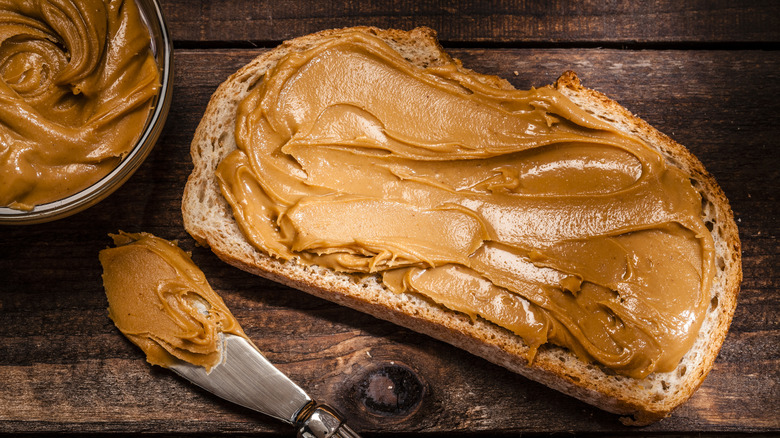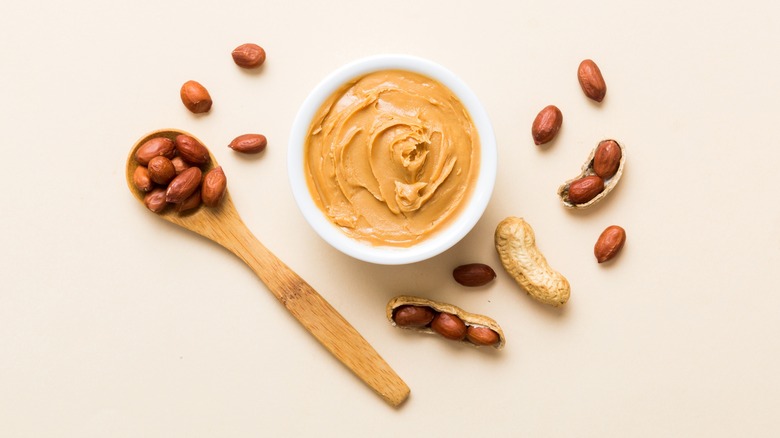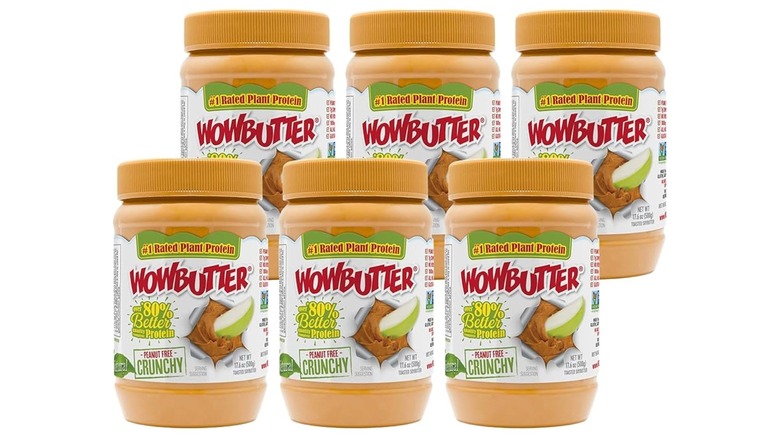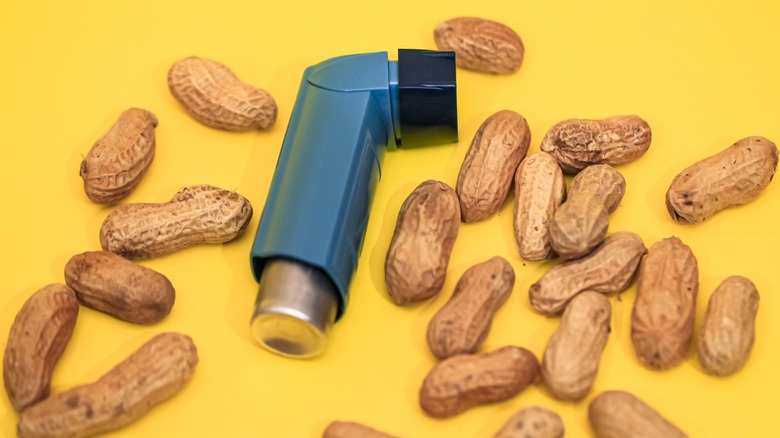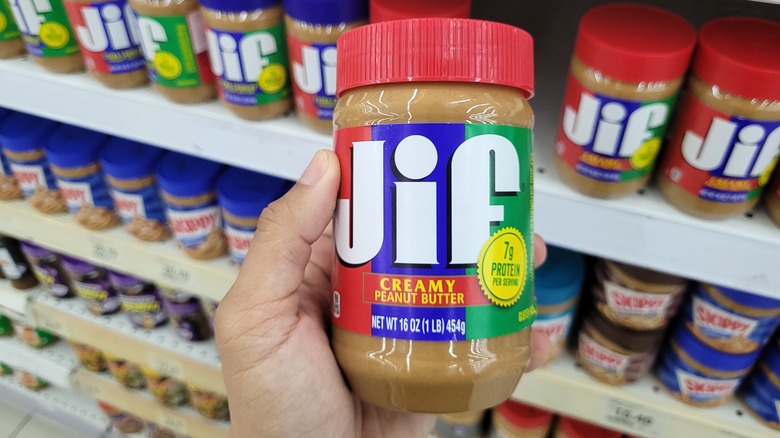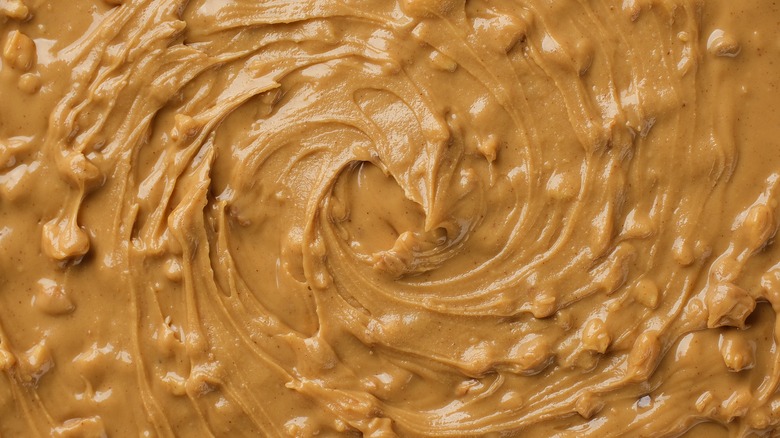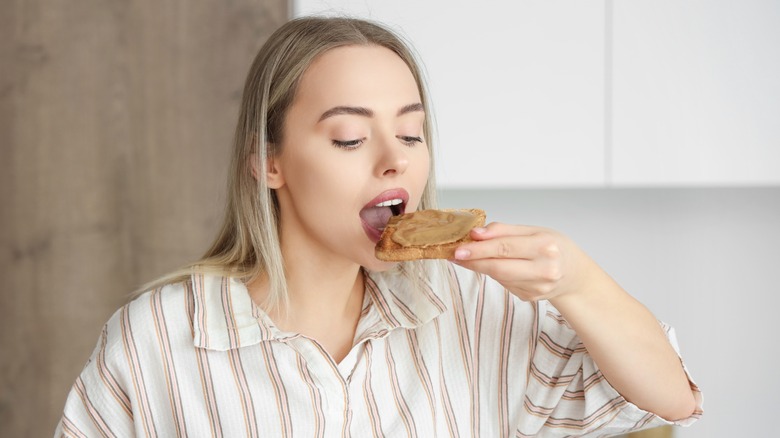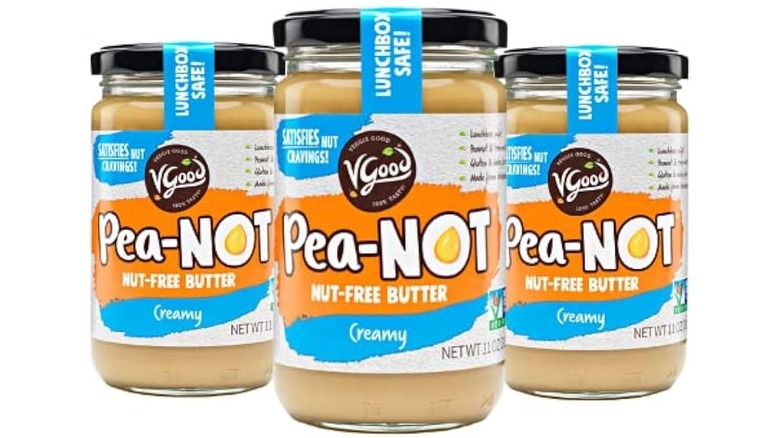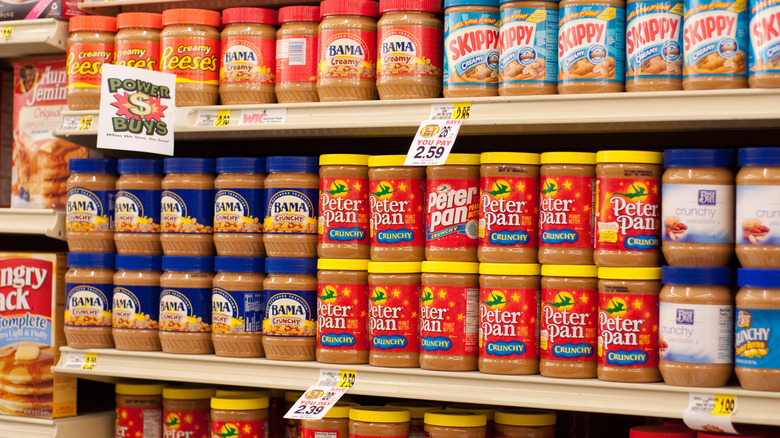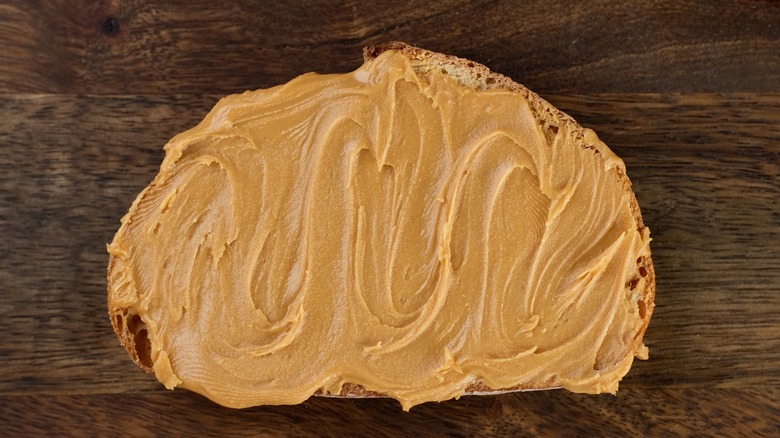Real Vs Fake Peanut Butter: What's The Difference?
People go nuts for peanut butter. And why wouldn't they? There are so many things you can do with peanut butter, it boggles the mind. This thick, creamy condiment complements a plethora of food products including celery, pretzels, and fruit. And of course, if it weren't for this nutty spread, we wouldn't have the beloved PB and J sandwich. But while peanut butter has been a pantry staple for generations, you might notice a similar product gaining popularity in recent years: fake peanut butter.
The term "fake peanut butter" may confuse some. After all, peanut butter is peanut butter, right? Well, not exactly. Nowadays you can find imitation food products of all kinds, from meat substitutes to vegan cheese, and nut butter is no different. So if you're craving peanut butter without the peanuts, you're in luck; brands like Wow Butter have developed peanut butter substitutes to satisfy those tastebuds.
However, before you decide between real versus imitation peanut butter, there are some things you should know. First off, what exactly is imitation peanut butter, and how does it stack up against the real thing? We're here to answer these questions and break down the differences in taste, texture, and ingredients. Keep reading for all the details so you can choose which is right for you.
What is real peanut butter?
Essentially, real peanut butter contains peanuts. However, per FDA regulations, peanut butter can only be labeled as such if it contains 90% peanuts and has only peanuts, fully hydrogenated oil, sweeteners, and salt. But for the sake of this article, we also consider "peanut butter spreads" to be the real thing. Although many of these spreads are made with palm oil rather than hydrogenated oils, the other ingredients, along with taste and texture, are almost identical.
Not surprisingly, real peanut butter tastes like — you guessed it — peanuts. Combined with a high fat content, this rich, nutty spread is super satisfying. Depending on the extra ingredients, peanut butter may also be salty and sweet. When it comes to texture, real peanut butter typically comes in creamy and chunky varieties. Anyone who's grown up eating PB and J sandwiches or ants on a log can immediately tell the difference.
You may also see peanut butter labeled as "natural." Many assume this means it's free of any processed oils and sweeteners, but truth be told, there aren't regulations determining what the term truly indicates. So while some natural peanut butter may only contain peanuts, the label itself isn't reliable. If you're searching for healthy, real peanut butter, you're better off buying an organic variety and checking the nutrition info to make sure it doesn't have unwanted ingredients.
What is fake peanut butter?
Fake peanut butter is any type of spread that imitates peanut butter without using actual peanuts. If you're a fan of real peanut butter, you might be wondering why people would mess with a good thing. If it's not broke, don't fix it, right? Well, people avoid peanuts for many reasons, from allergies and health concerns to taste preferences. And just because they don't want a peanut-based spread doesn't mean they should miss out on peanut butter's other characteristics. After all, that densely nutty flavor is super satiating, and the creamy texture works beautifully in desserts, sandwiches, or even as a dip.
If there aren't peanuts, what exactly is in imitation peanut butter? Ultimately, this depends on each particular product. One of the most popular imitation peanut butter brands, WOWBUTTER, uses toasted soy as the base ingredient. Other products may use granola or even chickpeas as the primary element. The differences don't stop there, either: Because of these different ingredients, imitation peanut butter has particular benefits and drawbacks compared to the real thing.
Imitation peanut butter is better when it comes to peanut allergies
According to Food Allergy Research and Education, allergies are on the rise. In the States alone, 1 in 10 adults and 1 in 13 children have a food allergy, and anaphylactic reactions have skyrocketed. While there are many different food allergies to blame, peanut allergy is one of the most common culprits. So if someone in your household is allergic, chances are, you don't want peanuts anywhere near the premises — in which case, it's imitation peanut butter to the rescue.
When it comes to allergies, imitation peanut butter is a safer bet because, as previously mentioned, it doesn't contain peanuts. In fact, many are made without any nuts or seeds at all. So if you want to go entirely nut-free, you can choose from a variety of spreads, like the soy-based WOWBUTTER or NoNuts Peabutter.
Making it clear which foods have been made with traditional peanut butter and which contain alternative ingredients is key in environments like school or summer camp. To make things easy, the WOWBUTTER brand includes identification stickers that state whatever they're stuck to is peanut and nut-free. So if your kid's classroom is a nut-free zone, these handy stickers might prevent panic.
Real peanut butter is easier to find
You can find real peanut butter everywhere. Walk into any grocery store, and you'll see brands like Skippy and Jif, with many sizes and varieties to choose from. These days, chain stores even have their own brands of peanut butter. Whole Foods 365 and Publix are just two of the stores that earned a high spot on our ranking of peanut butter brands.
On the other hand, imitation peanut butter brands aren't as widely available. Larger, well-known supermarkets might carry a few options. However, you're more likely to find them at health food stores, upscale markets, or online. Availability depends on the demand for each particular brand.
One popular choice is WOWBUTTER, which is available at Raleys and independent grocery stores. But if you'd like to see this soy-based butter at your local store, the company recommends printing its online promotional flyer and talking with the store manager. People have had luck with this approach in the past, so if you're a fan of WOWBUTTER — or other imitation nut butter brands — try taking matters into your own hands.
Real peanut butter is crunchier
Are you a creamy or crunchy fan? If you like things crunchy, you're not alone. Crunchiness is an appealing texture for many and the sound of grinding nuts is enough to trigger a craving. We're not sure why this is, but perhaps the love of all things crunchy stems from instinct. Having to chew longer gives the body more time to feel satiated; it also makes the food feel heartier. Whatever the reason, if you prefer crunchy peanut butter over smooth, real peanut butter is for you.
Real peanut butter contains chopped and ground-up peanuts, which have more crunchiness than imitation peanut butter spreads. Many believe this also enhances the taste. On Reddit, one fan describes why they love crunchy peanut butter so much: "I like to taste the nuts. It makes it fresher in my opinion." If regular crunchy peanut butter isn't enough for you, go for the extra crunchy variety, which is perfect as a topping or in peanut butter pastries.
If you can't eat peanuts, don't let FOMO get you down. You can still enjoy chunky varieties of imitation peanut butter, even if they don't have as strong of a crunch.
Imitation peanut butter might have an odd aftertaste
The whole point of imitation peanut butter is to resemble the real thing. And for the most part, these brands do a decent job. They can even be used in many of the same ways real peanut butter can. You can spread it over crackers, mix it into smoothies, or make no-bake cookies with it. However, don't expect it to taste exactly like the real thing.
Although many say imitation peanut butter tastes similar to real peanut butter, others have noted a slight aftertaste. One YouTuber mentioned that imitation peanut butter tastes closer to the real thing when eaten alongside food like crackers to mask the subtle differences. But when tasting WOWBUTTER, he explained, "It tastes exactly like peanut butter right at the beginning, but then you let it sit in your mouth for a little bit, and it's got very much of a soybean taste." This isn't surprising seeing how whole toasted soy is the first ingredient on the nutrition label.
Ultimately, if it's not made with peanuts, it's not going to taste like peanuts. But perhaps it's all about how you frame it. Instead of thinking of imitation peanut butter as peanut butter, consider these spreads as their own thing. WOWBUTTER is a soybean spread while Peabutter is a pea-based spread. They're both excellent within those niches.
Fake peanut butter has a wider variety of ingredients
Real peanut butter is pretty basic, containing only peanuts, oil, salt, and sweeteners. However, imitation peanut butter isn't labeled as "peanut butter," so it doesn't have to abide by the same rules — which means it can come with a far longer list of ingredients. And since there are several different kinds of imitation peanut butter out there, there's a wider array of ingredients as well.
With peanut butter substitutes, you really don't know what you're going to get. WOWBUTTER actually has a similar ingredient list to most peanut butter. It contains oil, sugar, and salt — but instead of peanuts, the product uses whole toasted soy. The contents of Original No Nuts Peabutter are also similar to real peanut butter but with brown peas. But other brands have a much more creative ingredient list that doesn't resemble peanut butter at all. For example, Oat Haus Granola Butter is made with gluten-free oats, maple syrup, cinnamon, and ginger, among other things.
Real peanut butter is often cheaper
More often than not, real peanut butter is cheaper than imitations. Real peanut butter has been around for a very long time, and since many companies sell it, it's priced competitively. Plus, peanuts tend to be cheaper than other nuts, like almonds and cashews, and the sorts of things imitation butters use as a base. Thus, imitation butter is likely to have a heftier price tag as well.
To give you some frame of reference, you can find a 16 ounce jar of Jif's peanut butter for under $5. However, similarly sized peanut butter alternatives can cost upwards of $10. An 11 ounce jar of VGood's PeaNot Butter approaches the $10 mark at $9.99. Meanwhile, Oat Haus Original Granola Butter is over $12 for a 12 ounce jar, so you're paying far more than Jif for a smaller amount.
Perhaps the ingredients are more expensive and harder to source — or perhaps these companies are capitalizing on the trendy nature of peanut butter alternatives. Nowadays, people will pay high prices for nutritious foods; they see it as an investment in their health. Knowing this, these no-peanut spreads might decide to market to this very audience.
Imitation peanut butter often has less sodium
Watching your sodium intake? You may want to look at that peanut butter nutrition label. Peanut butter's sodium content varies from brand to brand. Jif's creamy peanut butter has 140 milligrams of sodium per 2-tablespoon serving. That's 6% of the recommended daily intake, which doesn't sound like much, but these numbers add up (especially considering the shocking amount of peanut butter the average person consumes). Mind you, sodium is not inherently bad. We need it for muscle and nerve function and to maintain proper electrolyte balance. However, too much can cause cardiovascular issues. So if your doctor warned you to go easy on the sodium, keep your eye out for added salt in peanut butter, or opt for an alternative with low sodium.
Many imitation peanut butter brands cater to health-conscious consumers, and one strategy to appeal to this market is reducing sodium content. Oat Haus Granola Butter has just 35 milligrams of sodium per serving, a quarter of the amount we saw in Jif's. However, if you want that real peanut butter taste without the sodium, you're in luck. Many brands now offer salt-free varieties like Trader Joe's Crunchy Unsalted Peanut Butter, which has 0 grams of sodium per serving.
The consistency of imitation peanut butter is less reliable
One major difference between real and imitation peanut butter is consistency. With a reliable list of ingredients, you know what to expect when you open a jar of real peanut butter: A flavorful spread boasting a smooth and creamy texture (with chunks of real peanuts if you've gone the crunchy route). Of course, temperature and storage conditions can affect this texture, but these are somewhat within your control. In contrast, imitation butters are less reliable.
The consistency of imitation peanut butter depends on the brand and ingredients. Some can be far thicker while others are runny. On a thread discussing Oat Haus Granola Butter, one Redditor wrote, "That texture reminded me of soup or syrup." This might work if you're mixing the spread into a yogurt parfait, but less so if you're using it as a binder in baked goods. Another Reddit user detailed the consistency of WOWBUTTER, commenting, "The texture is good. It does get a bit oily/almost watery once you get to the lower portion of the jar." Luckily, this sounds like a simple fix; make sure to stir as you work your way through the jar and you should be good to go.
